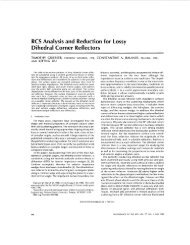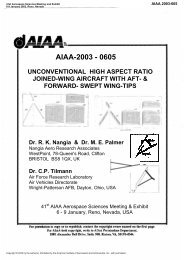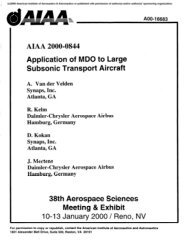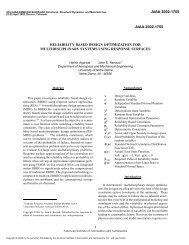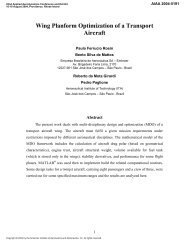The design report
The design report
The design report
You also want an ePaper? Increase the reach of your titles
YUMPU automatically turns print PDFs into web optimized ePapers that Google loves.
Fuselage fabrication 5.2<br />
Since there were two fuselages, it was decided that it would be wise to start with the<br />
first one and get familiarised with it, then start with the second one. This is very useful<br />
as there may be mistakes during manufacture the first fuselage and the mistake could<br />
actually be corrected without wasting additional material. A couple of mistakes were<br />
found while making the first fuselage. For example, the two top plates were made<br />
exactly the same initially in CATIA. During the fabrication process of the second fuselage,<br />
we found that the bottom plate did not fit as there were locking mechanisms stopping it<br />
from clicking in. <strong>The</strong> bottom top plate was then cut out so that it could easily slide<br />
through the ribs and not click in like the top one. Realisation occurred at the time about<br />
the fact that processes in CATIA does not necessarily ensure fabrication success<br />
<strong>The</strong> order of the fabrication was fairly simple. CATIA files had to be converted into .dxf<br />
files and rearrange all the parts in AutoCAD to fit the given dimensions of different<br />
materials that we were using. <strong>The</strong> files were then run in the laser programme and the<br />
laser will cut the exact part out for us. <strong>The</strong> problem with this part is that some of the<br />
planks of wood were not entirely flat so there were minor errors when the laser<br />
machine was cutting the parts. Those errors were small enough to neglect so it did not<br />
cause a big problem. It had to be ensured that tiny parts were required to cut, as it<br />
might fall through the gaps under the planks. It is best to slide a thin sheet of used balsa<br />
to stop that from happening.<br />
<strong>The</strong> fuselage <strong>design</strong> consisted on many interlocking parts to ensure all connectivity was<br />
well secured. Gluing was only a secondary process of connection and only in place to<br />
avoid slipping.<br />
<strong>The</strong> <strong>design</strong> of the fuselage had readymade slots for everything to be locked together so<br />
figuring out the actual position of each rib was not at all a problem. Extra effort was<br />
taken into strengthening the connections, for example, the centre plate and the<br />
longerons that had to be split into two due to the restriction of length were to sandwich<br />
it with two carbon strips on the joints. That would have ensured that the joining of two<br />
would not split apart during flight or when carrying a load.<br />
After gluing everything into place, the fuselage was to be left overnight to dry<br />
completely. <strong>The</strong>re were three different types of glue that we used (AB Glue, Superglue,<br />
PVA Glue). Each glue needed different amount of time to dry so it all depends on which<br />
glue was used. PVA glue was the glue used for parts that did not do heavy duty work<br />
and superglue was the glue when you needed something to be in place instantly while<br />
AB glue was the strongest of all and it was to be used on parts the take heavy loads.








![Introduction to RF Stealth [Book Review] - Antennas and ...](https://img.yumpu.com/16857890/1/190x245/introduction-to-rf-stealth-book-review-antennas-and-.jpg?quality=85)

